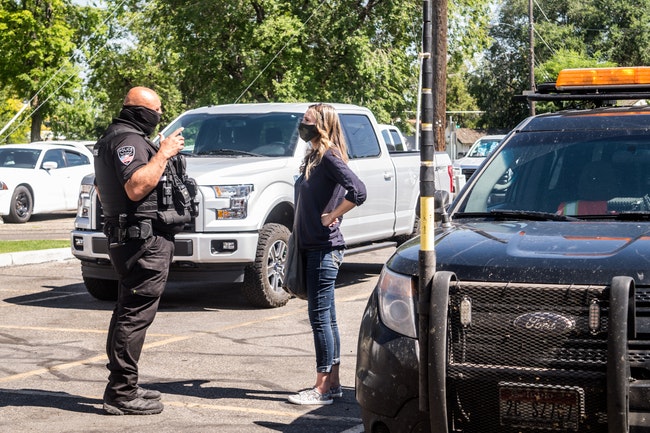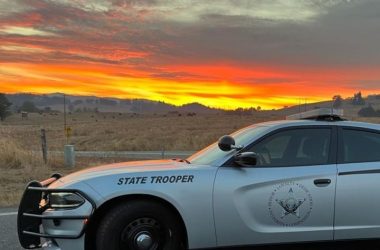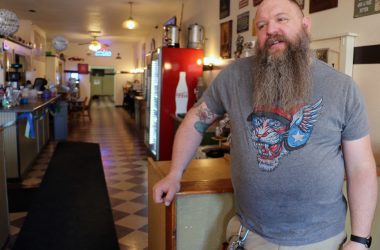
Tommy Elizondo of the Ontario Police Department, speaks with a woman from Idaho in an effort to recover a stolen vehicle. (Kezia Setyawan/The Enterprise)
ONTARIO – Despite Gov. Kate Brown’s statewide mask mandate and rapid Covid spread in Malheur County, some officers in the Ontario Police Department aren’t wearing face coverings at all times.
Police Chief Steven Romero reasons that “police work is based on communications,” and problems arise when people or fellow officers can’t understand what the officer is saying through a mask. For example, he said, when the department pursued three murder suspects a few weeks ago, officers had to communicate over the radio systems, which “are already not the best.”
“Imagine having to try to communicate to your dispatcher, your fellow law enforcement officers, or anyone else through a mask during a high-risk, dynamic, fluid scenario,” said Romero.
However, police officers are wearing masks during “routine activities,” such as in the office, dealing with calls for service or working on “non-emergent tasks,” he said.
“Some choose not to wear them while driving around and alone in their cars or when they make initial contact on traffic stops or subject contacts,” said Romero.
Masks complicate police work, Romero said, when officers are communicating directions to suspects or those pulled over in a traffic stop. Miscommunication from wearing a mask can “create legal defenses for people,” giving them the opportunity to make claims that they couldn’t understand the officer and weren’t given proper explanation.
“Your suspects cannot misinterpret what you’re telling them to do,” said Romero. “You give a command, and they don’t understand it, and they do something that now is perceived as a threat because they couldn’t quite hear your communication clearly and precisely, that could lead to catastrophic results.”
On July 1, Brown required Oregonians to wear a face mask while inside public spaces. On July 13, she expanded the mask mandate to apply to outdoor settings when social distancing can’t be maintained. The rule was extended to children age 5 and older on July 22.
“Under OHA guidance on face coverings, all Oregonians must wear face coverings in indoor public places and outdoors when six feet of physical distance cannot be maintained,” said Charles Boyle, deputy communications director for the governor’s office, in response to whether masks are required for police officers.
Philip Schmidt, health authority public information officer, said Brown’s mandates “apply to all Oregonians except those with a medical exception.”
“[If they are] on duty in an indoor space open to the public as defined in the guidance, or on duty outdoors where they cannot maintain 6 feet of distance from other people, they need to wear a mask,” said Schmidt.
The county has seen a significant increase in Covid cases since July. During the week of June 7-13, the positive testing rate was 4%, and the week of July 19-25, the rate was at 20.8%, according to the Oregon Health Authority. As of Saturday, there were 674 Covid cases, 10 deaths and a positive testing rate of 17.7%, according to the Malheur County Health Department.
The police department itself took a hit from Covid and has had five officers out sick with the virus. All have recovered and are back at work.
Officer Tomas Elizondo said “masks make some parts harder to do your job,” like when trying to identify a shoplifter, for example. However, Elizondo was one of the officers who had Covid, and said he “wants people to take the disease seriously.”
With only 23 officers, the department is already very low on resources, Romero said.
“The department’s already too small for the level of work that we have to produce here,” said Romero. “So, when you start losing people, it hurts.”
But police work is not like “any other business,” said Romero, where one has “complete control of the environment” and can more easily implement Covid best practices.
“You can’t expect a cop to be able to wear their mask all day long,” said Romero. “Let’s say you’ve got to jump out of your car really quick because someone jumps out on you on a traffic stop or on a subject stop. Cops don’t have time to sit there and worry about putting on a mask in those types of dynamic scenarios.”
Romero said his “best-case scenario” Covid policies “parallel” those of the Centers for Disease Control and Prevention, state health organizations and county health departments, such as wearing masks and social distancing, but are only done under “ideal control conditions,” where there is not an “immediate threat” or “communication concerns.”
“When it becomes feasible and practical, and it’s safe enough to do so, then we tell our officers what the policy recommendation is, and then go ahead and mask up or mask up your suspect,” said Romero.
The toughest part, Romero said, is having “to learn to adjust to rules and policies that are being created by non-police people,” who do not take into account “how it impacts us.”
“Non-subject experts don’t think about all that,” said Romero. “I wouldn’t expect them to because they’re not subject experts. That’s like me trying to tell a surgeon how to best do surgery.”
Reporter Kezia Setyawan contributed to this report.
News tip? Contact the Malheur Enterprise by email at [email protected] or call 541-473-3377.
KEEP THE ENTERPRISE GOING AS OTHERS CLOSE…..
Reader support allows the Enterprise to provide in-depth, accurate reporting that otherwise would not get done. Keeping the community well informed is essential. SUBSCRIBE – $5 a month, automatically. DONATE – to provide additional support.




